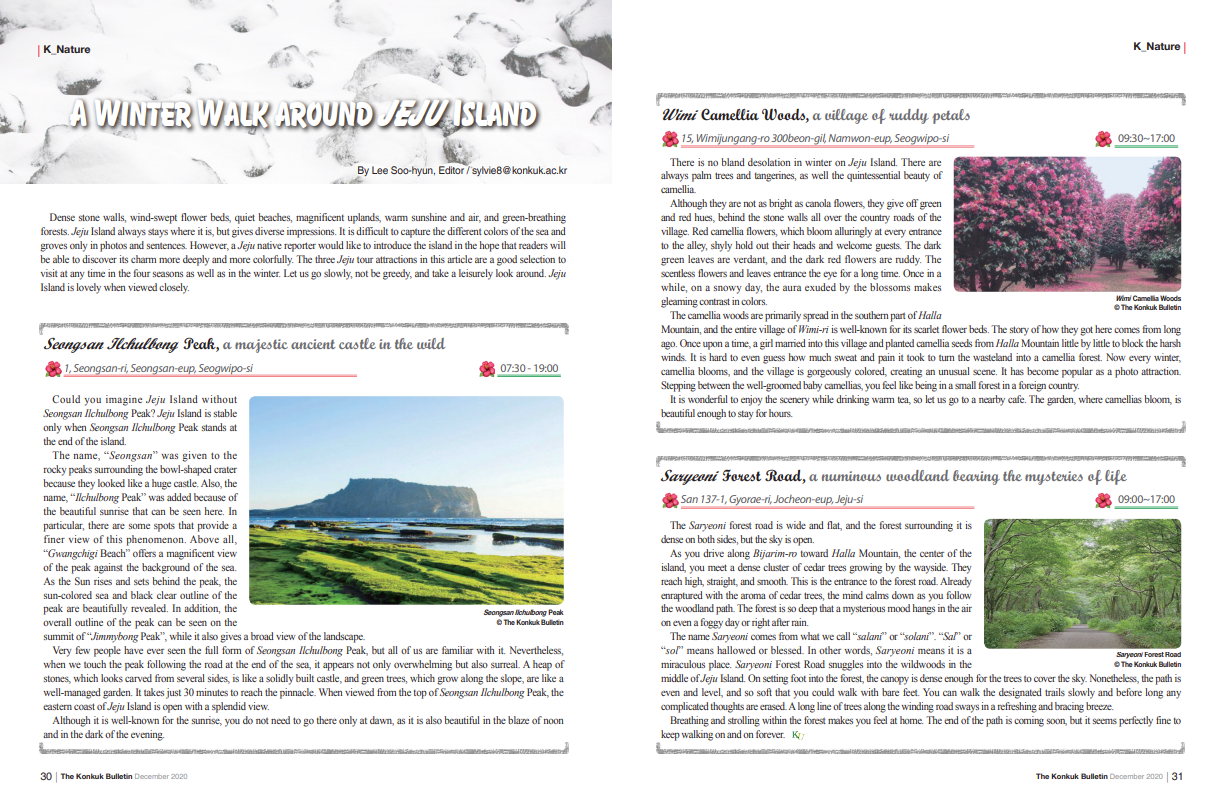
Dense stone walls, wind-swept flower beds, quiet beaches, magnificent uplands, warm sunshine and air, and green-breathing forests. Jeju Island always stays where it is, but gives diverse impressions. It is difficult to capture the different colors of the sea and groves only in photos and sentences. However, a Jeju native reporter would like to introduce the island in the hope that readers will be able to discover its charm more deeply and more colorfully. The three Jeju tour attractions in this article are a good selection to visit at any time in the four seasons as well as in the winter. Let us go slowly, not be greedy, and take a leisurely look around. Jeju Island is lovely when viewed closely.
Seongsan Ilchulbong Peak, a majestic ancient castle in the wild
1, Seongsan-ri, Seongsan-eup, Seogwipo-si
Could you imagine Jeju Island without Seongsan Ilchulbong Peak? Jeju Island is stable only when Seongsan Ilchulbong Peak stands at the end of the island.
The name, “Seongsan” was given to the rocky peaks surrounding the bowl-shaped crater because they looked like a huge castle. Also, the name, “Ilchulbong Peak” was added because of the beautiful sunrise that can be seen here. In particular, there are some spots that provide a finer view of this phenomenon. Above all, “Gwangchigi Beach” offers a magnificent view of the peak against the background of the sea. As the Sun rises and sets behind the peak, the sun-colored sea and black clear outline of the peak are beautifully revealed. In addition, the overall outline of the peak can be seen on the summit of “Jimmybong Peak”, while it also gives a broad view of the landscape.
Very few people have ever seen the full form of Seongsan Ilchulbong Peak, but all of us are familiar with it. Nevertheless, when we touch the peak following the road at the end of the sea, it appears not only overwhelming but also surreal. A heap of stones, which looks carved from several sides, is like a solidly built castle, and green trees, which grow along the slope, are like a well-managed garden. It takes just 30 minutes to reach the pinnacle. When viewed from the top of Seongsan Ilchulbong Peak, the eastern coast of Jeju Island is open with a splendid view.
Although it is well-known for the sunrise, you do not need to go there only at dawn, as it is also beautiful in the blaze of noon and in the dark of the evening.
Wimi Camellia Woods, a village of ruddy petals
15, Wimijungang-ro 300beon-gil, Namwon-eup, Seogwipo-si
There is no bland desolation in winter on Jeju Island. There are always palm trees and tangerines, as well the quintessential beauty of camellia.
Although they are not as bright as canola flowers, they give off green and red hues, behind the stone walls all over the country roads of the village. Red camellia flowers, which bloom alluringly at every entrance to the alley, shyly hold out their heads and welcome guests. The dark green leaves are verdant, and the dark red flowers are ruddy. The scentless flowers and leaves entrance the eye for a long time. Once in a while, on a snowy day, the aura exuded by the blossoms makes gleaming contrast in colors.
The camellia woods are primarily spread in the southern part of Halla Mountain, and the entire village of Wimi-ri is well-known for its scarlet flower beds. The story of how they got here comes from long ago. Once upon a time, a girl married into this village and planted camellia seeds from Halla Mountain little by little to block the harsh winds. It is hard to even guess how much sweat and pain it took to turn the wasteland into a camellia forest. Now every winter, camellia blooms, and the village is gorgeously colored, creating an unusual scene. It has become popular as a photo attraction. Stepping between the well-groomed baby camellias, you feel like being in a small forest in a foreign country.
It is wonderful to enjoy the scenery while drinking warm tea, so let us go to a nearby cafe. The garden, where camellias bloom, is beautiful enough to stay for hours.
Saryeoni Forest Road, a numinous woodland bearing the mysteries of life
San 137-1, Gyorae-ri, Jocheon-eup, Jeju-si
The Saryeoni forest road is wide and flat, and the forest surrounding it is dense on both sides, but the sky is open.
As you drive along Bijarim-ro toward Halla Mountain, the center of the island, you meet a dense cluster of cedar trees growing by the wayside. They reach high, straight, and smooth. This is the entrance to the forest road. Already enraptured with the aroma of cedar trees, the mind calms down as you follow the woodland path. The forest is so deep that a mysterious mood hangs in the air on even a foggy day or right after rain.
The name Saryeoni comes from what we call “salani” or “solani”. “Sal” or “sol” means hallowed or blessed. In other words, Saryeoni means it is a miraculous place. Saryeoni Forest Road snuggles into the wildwoods in the middle of Jeju Island. On setting foot into the forest, the canopy is dense enough for the trees to cover the sky. Nonetheless, the path is even and level, and so soft that you could walk with bare feet. You can walk the designated trails slowly and before long any complicated thoughts are erased. A long line of trees along the winding road sways in a refreshing and bracing breeze.
Breathing and strolling within the forest makes you feel at home. The end of the path is coming soon, but it seems perfectly fine to keep walking on and on forever.

